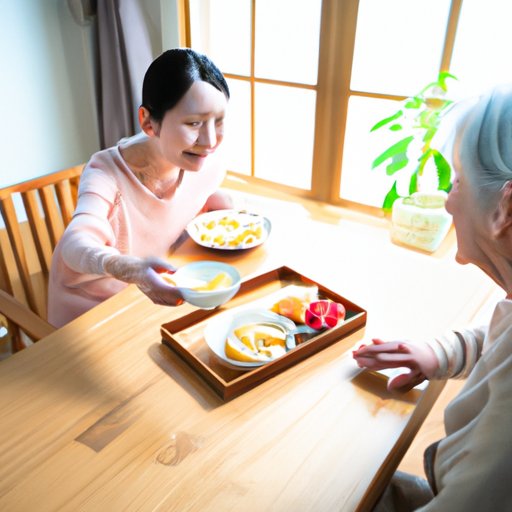Introduction
As people age, they often experience difficulty when it comes to eating. Many elderly individuals have trouble with chewing and swallowing, as well as a decreased appetite due to medical conditions or medications. This can lead to malnutrition, dehydration, and other health concerns. For caregivers, getting the elderly to eat can be a challenge. In this article, we will explore ways to make mealtime more enjoyable and encourage elderly individuals to eat.
Offer a Variety of Healthy Foods
When preparing meals for elderly individuals, it is important to choose nutritious options that are high in protein, vitamins, and minerals. This will help ensure that the elderly person is receiving the necessary nutrients for their health. It is also important to consider individual preferences and dietary restrictions. If the individual has allergies or other restrictions, meals should be tailored accordingly. Additionally, it is important to provide a variety of food options to keep mealtime interesting.
Serve Smaller Portions
Serving smaller portions can help make mealtime more manageable for the elderly person. This can also help reduce the risk of overeating, which can lead to indigestion and other unpleasant side effects. If the individual is still hungry after finishing their meal, additional servings can be provided if needed.
Make Mealtime Social
Eating alone can be lonely and unappealing for elderly individuals. To make mealtime more enjoyable, try engaging in conversation while eating. Inviting family members or friends to join mealtime can also provide companionship and support. This can be an opportunity for socialization and connection with others, which can be beneficial for physical and mental wellbeing.
Provide Assistance with Eating
For those who are physically unable to feed themselves, caregivers may need to provide assistance with eating. Utensils and dishes designed for elderly individuals can make mealtime easier. These items can include adaptive utensils, curved plates, and non-slip bowls. Additionally, providing assistance when needed can ensure that meals are eaten safely and properly.
Make Food Visually Appealing
Elderly individuals may not have much of an appetite, so it is important to make food visually appealing. Plates and bowls can be chosen in bright colors to add interest. Additionally, food can be arranged attractively on the plate to make it more enticing. Even small changes like these can help make mealtime more enjoyable.
Conclusion
Getting elderly individuals to eat can be challenging, but there are strategies that can help. Offering a variety of healthy foods, serving smaller portions, making mealtime social, providing assistance with eating, and making food visually appealing can all help to make mealtime more enjoyable and encourage elderly individuals to eat. As a caregiver, it is important to provide encouragement and support to ensure that elderly individuals receive proper nutrition.
(Note: Is this article not meeting your expectations? Do you have knowledge or insights to share? Unlock new opportunities and expand your reach by joining our authors team. Click Registration to join us and share your expertise with our readers.)
